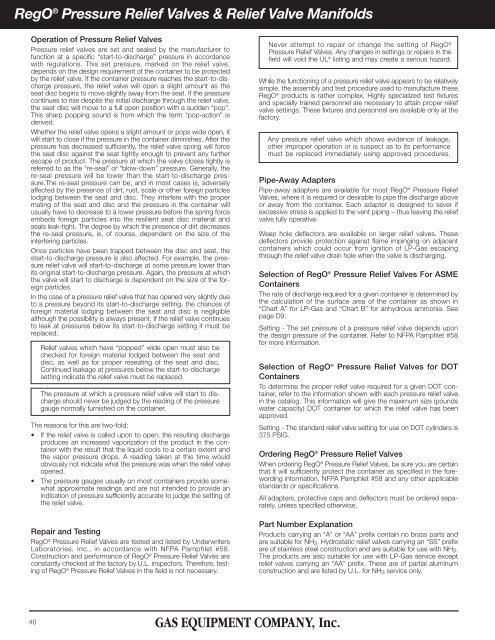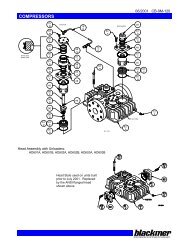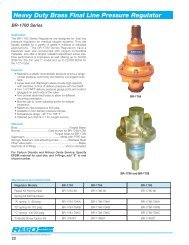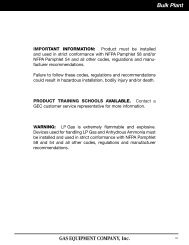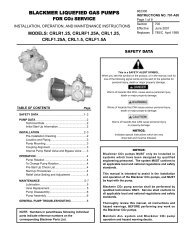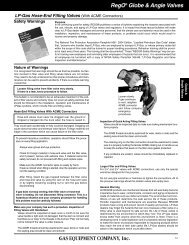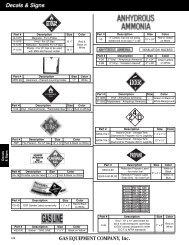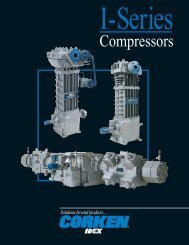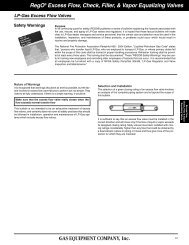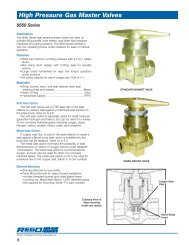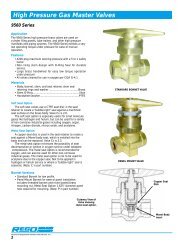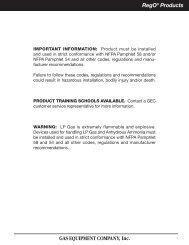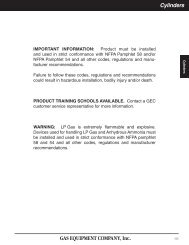RegO® Cylinder & Service Valves - Gas Equipment Company, Inc.
RegO® Cylinder & Service Valves - Gas Equipment Company, Inc.
RegO® Cylinder & Service Valves - Gas Equipment Company, Inc.
You also want an ePaper? Increase the reach of your titles
YUMPU automatically turns print PDFs into web optimized ePapers that Google loves.
RegO ® Pressure Relief <strong>Valves</strong> & Relief Valve Manifolds<br />
Operation of Pressure Relief <strong>Valves</strong><br />
Pressure relief valves are set and sealed by the manufacturer to<br />
function at a specific “start-to-discharge” pressure in accordance<br />
with regulations. This set pressure, marked on the relief valve,<br />
depends on the design requirement of the container to be protected<br />
by the relief valve. If the container pressure reaches the start-to-discharge<br />
pressure, the relief valve will open a slight amount as the<br />
seat disc begins to move slightly away from the seat. If the pressure<br />
continues to rise despite the initial discharge through the relief valve,<br />
the seat disc will move to a full open position with a sudden “pop”.<br />
This sharp popping sound is from which the term “pop-action” is<br />
derived.<br />
Whether the relief valve opens a slight amount or pops wide open, it<br />
will start to close if the pressure in the container diminishes. After the<br />
pressure has decreased sufficiently, the relief valve spring will force<br />
the seat disc against the seat tightly enough to prevent any further<br />
escape of product. The pressure at which the valve closes tightly is<br />
referred to as the “re-seal” or “blow-down” pressure. Generally, the<br />
re-seal pressure will be lower than the start-to-discharge pressure.The<br />
re-seal pressure can be, and in most cases is, adversely<br />
affected by the presence of dirt, rust, scale or other foreign particles<br />
lodging between the seat and disc. They interfere with the proper<br />
mating of the seat and disc and the pressure in the container will<br />
usually have to decrease to a lower pressure before the spring force<br />
embeds foreign particles into the resilient seat disc material and<br />
seals leak-tight. The degree by which the presence of dirt decreases<br />
the re-seal pressure, is, of course, dependent on the size of the<br />
interfering particles.<br />
Once particles have been trapped between the disc and seat, the<br />
start-to-discharge pressure is also affected. For example, the pressure<br />
relief valve will start-to-discharge at some pressure lower than<br />
its original start-to-discharge pressure. Again, the pressure at which<br />
the valve will start to discharge is dependent on the size of the foreign<br />
particles.<br />
In the case of a pressure relief valve that has opened very slightly due<br />
to a pressure beyond its start-to-discharge setting, the chances of<br />
foreign material lodging between the seat and disc is negligible<br />
although the possibility is always present. If the relief valve continues<br />
to leak at pressures below its start-to-discharge setting it must be<br />
replaced.<br />
Relief valves which have “popped” wide open must also be<br />
checked for foreign material lodged between the seat and<br />
disc, as well as for proper reseating of the seat and disc.<br />
Continued leakage at pressures below the start-to-discharge<br />
setting indicate the relief valve must be replaced.<br />
The pressure at which a pressure relief valve will start to discharge<br />
should never be judged by the reading of the pressure<br />
gauge normally furnished on the container.<br />
The reasons for this are two-fold:<br />
• If the relief valve is called upon to open, the resulting discharge<br />
produces an increased vaporization of the product in the container<br />
with the result that the liquid cools to a certain extent and<br />
the vapor pressure drops. A reading taken at this time would<br />
obviously not indicate what the pressure was when the relief valve<br />
opened.<br />
• The pressure gauges usually on most containers provide somewhat<br />
approximate readings and are not intended to provide an<br />
indication of pressure sufficiently accurate to judge the setting of<br />
the relief valve.<br />
Never attempt to repair or change the setting of RegO ®<br />
Pressure Relief <strong>Valves</strong>. Any changes in settings or repairs in the<br />
field will void the UL ® listing and may create a serious hazard.<br />
While the functioning of a pressure relief valve appears to be relatively<br />
simple, the assembly and test procedure used to manufacture these<br />
RegO ® products is rather complex. Highly specialized test fixtures<br />
and specially trained personnel are necessary to attain proper relief<br />
valve settings. These fixtures and personnel are available only at the<br />
factory.<br />
Any pressure relief valve which shows evidence of leakage,<br />
other improper operation or is suspect as to its performance<br />
must be replaced immediately using approved procedures.<br />
Pipe-Away Adapters<br />
Pipe-away adapters are available for most RegO ® Pressure Relief<br />
<strong>Valves</strong>, where it is required or desirable to pipe the discharge above<br />
or away from the container. Each adapter is designed to sever if<br />
excessive stress is applied to the vent piping – thus leaving the relief<br />
valve fully operative.<br />
Weep hole deflectors are available on larger relief valves. These<br />
deflectors provide protection against flame impinging on adjacent<br />
containers which could occur from ignition of LP-<strong>Gas</strong> escaping<br />
through the relief valve drain hole when the valve is discharging.<br />
Selection of RegO ® Pressure Relief <strong>Valves</strong> For ASME<br />
Containers<br />
The rate of discharge required for a given container is determined by<br />
the calculation of the surface area of the container as shown in<br />
“Chart A” for LP-<strong>Gas</strong> and “Chart B” for anhydrous ammonia. See<br />
page D9.<br />
Setting - The set pressure of a pressure relief valve depends upon<br />
the design pressure of the container. Refer to NFPA Pamphlet #58<br />
for more information.<br />
Selection of RegO ® Pressure Relief <strong>Valves</strong> for DOT<br />
Containers<br />
To determine the proper relief valve required for a given DOT container,<br />
refer to the information shown with each pressure relief valve<br />
in the catalog. This information will give the maximum size (pounds<br />
water capacity) DOT container for which the relief valve has been<br />
approved.<br />
Setting - The standard relief valve setting for use on DOT cylinders is<br />
375 PSIG.<br />
Ordering RegO ® Pressure Relief <strong>Valves</strong><br />
When ordering RegO ® Pressure Relief <strong>Valves</strong>, be sure you are certain<br />
that it will sufficiently protect the container as specified in the forewording<br />
information, NFPA Pamphlet #58 and any other applicable<br />
standards or specifications.<br />
All adapters, protective caps and deflectors must be ordered separately,<br />
unless specified otherwise.<br />
Repair and Testing<br />
RegO ® Pressure Relief <strong>Valves</strong> are tested and listed by Underwriters<br />
Laboratories, <strong>Inc</strong>., in accordance with NFPA Pamphlet #58.<br />
Construction and performance of RegO ® Pressure Relief <strong>Valves</strong> are<br />
constantly checked at the factory by U.L. inspectors. Therefore, testing<br />
of RegO ® Pressure Relief <strong>Valves</strong> in the field is not necessary.<br />
Part Number Explanation<br />
Products carrying an “A” or “AA” prefix contain no brass parts and<br />
are suitable for NH 3 . Hydrostatic relief valves carrying an “SS” prefix<br />
are of stainless steel construction and are suitable for use with NH 3 .<br />
The products are also suitable for use with LP-<strong>Gas</strong> service except<br />
relief valves carrying an “AA” prefix. These are of partial aluminum<br />
construction and are listed by U.L. for NH 3 service only.<br />
40


